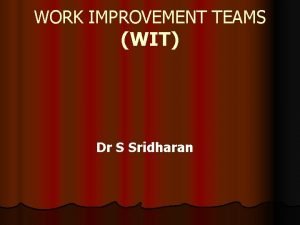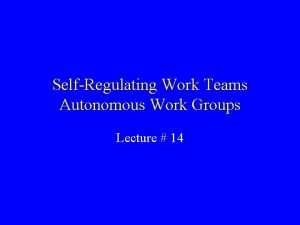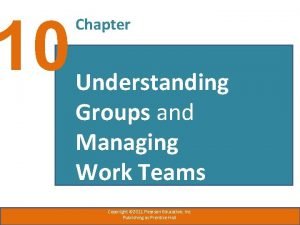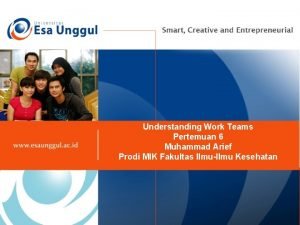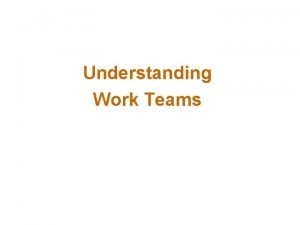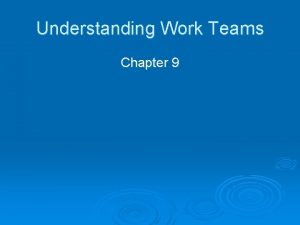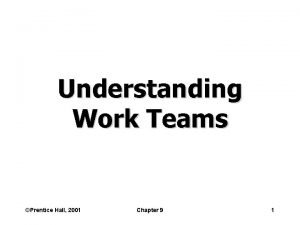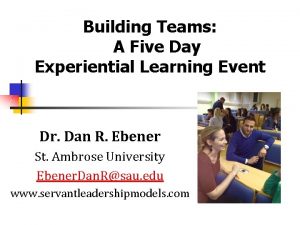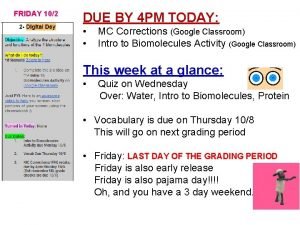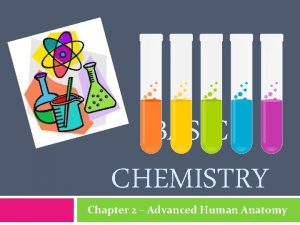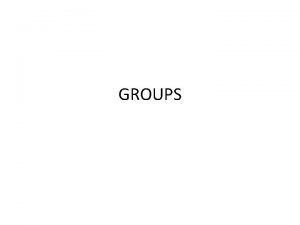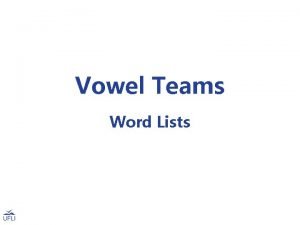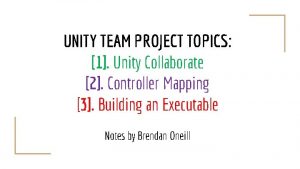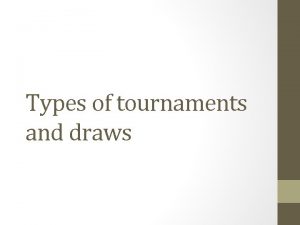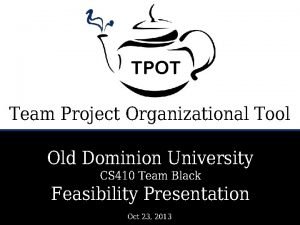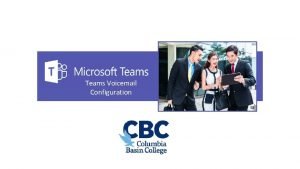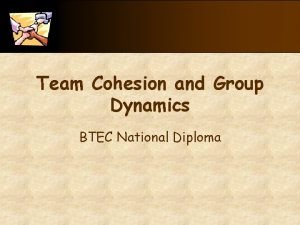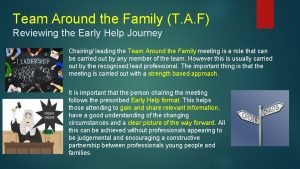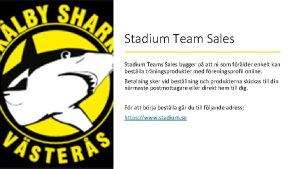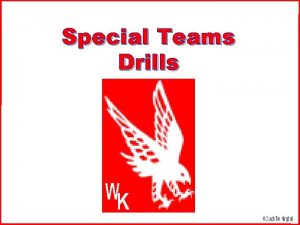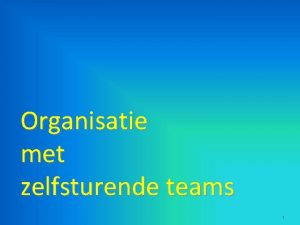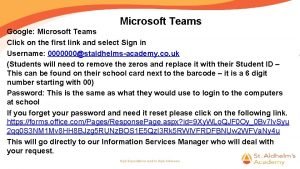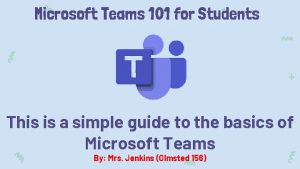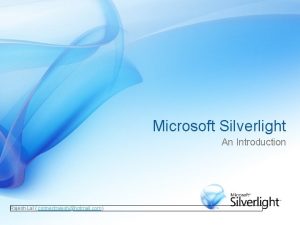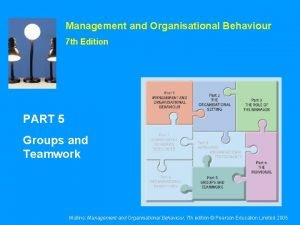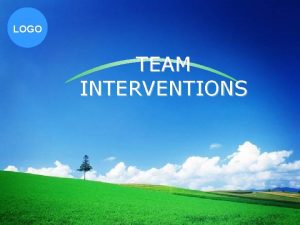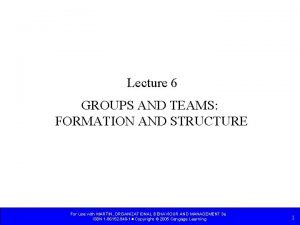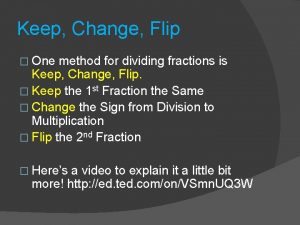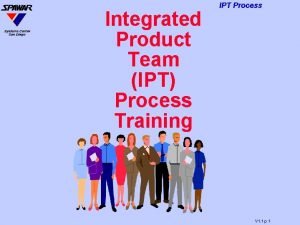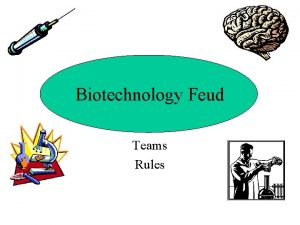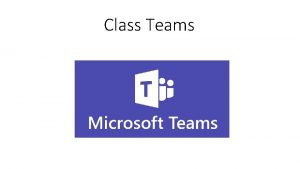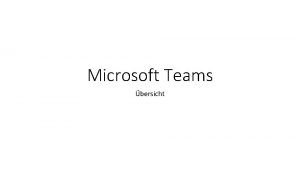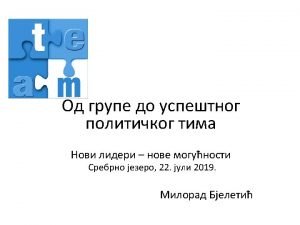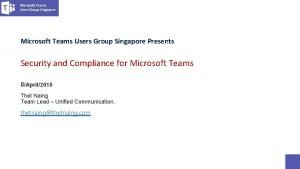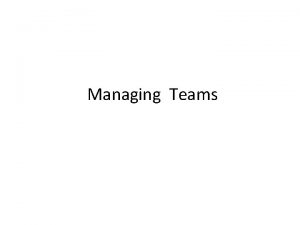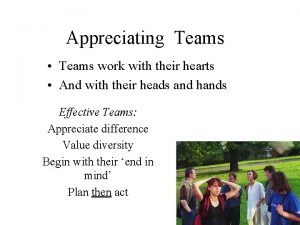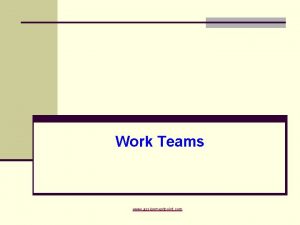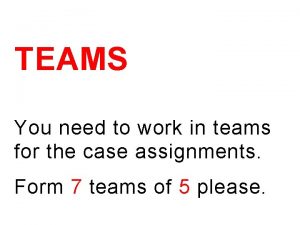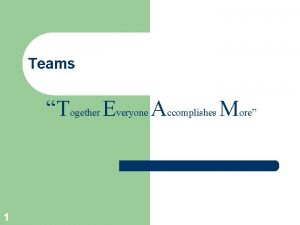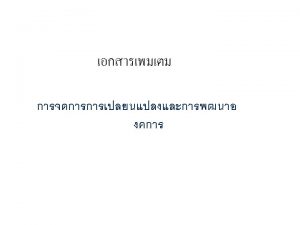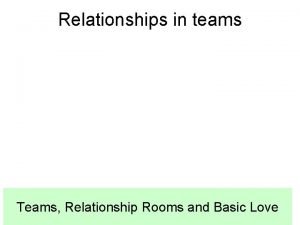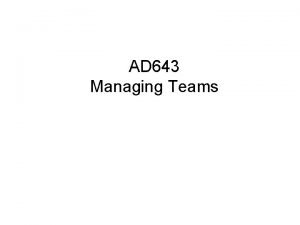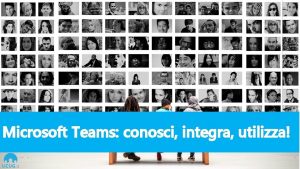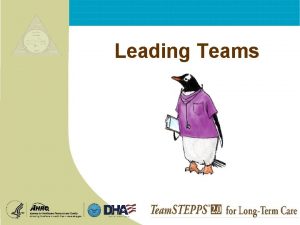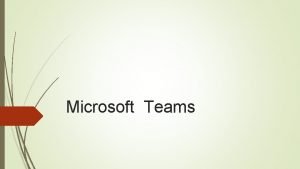WORK TEAMS What is a work group It











































- Slides: 43

WORK TEAMS

What is a work group? • It is a group that interacts primarily to share information and to make decisions to help each member perform within his or her area of responsibility (Robbins & Judge, 2013)

What is a work team? • 2+2+3= 8 • A group whose individual efforts result in a performance that is greater than the sum of the individual inputs.


Difference between groups and teams Group 1) No positive synergy and coordination 2) Goal is to share information 3) Individual members are accountable for the performance 4)Members possess random and varied skills Team 1) Coordinated effort and positive synergy 2) Goal is collective performance 3) Accountability is on the individual as well as mutual 4) In a work team skills of group members are complementary

TYPES OF TEAMS PROBLEM SOLVING TEAMS SELF MANAGED WORK TEAMS VIRTUAL TEAMS CROSS FUNCTIONAL TEAMS




1. PROBLEM SOLVING TEAMS • Groups of 5 -12 employees • Meets regularly every week • Discussions held on improving QUALITY, EFFICIENCY and WORK ENVIRONMENT • Limited authority to implement suggestions

2. SELF MANAGED WORK TEAMS • Groups of 10 -15 people • Take responsibilities of their former supervisors • Have authority to implement changes

Tasks of self managed teams 1) Planning and scheduling of work 2) Assigning work to members 3) Making operating decisions 4) Identifying and solving problems 5) Dealing with suppliers and with customers • Some SMTs select members and evaluate their performance • No supervisor is there.

Negative aspects • Unable to manage conflicts well • No cooperation among members during disputes • Higher rates of absenteeism and employee turnover rates. Despite all these, the sense of job satisfaction is high for the members.

3. CROSS FUNCTIONAL TEAMS • Employees from the same hierarchical level • Working in different work areas • Work together to accomplish a task • Similar to social networking groups • Works together for the completion of large and complex projects

4. VIRTUAL TEAMS • Use of computer technology • To bind physically dispersed members together • Communication is online • Less social rapport • Less sharing of information

How to improve the effectiveness of virtual teams? 1) Create trust among team members 2) Monitor the progress of the team 3) Publicizing the efforts and outcomes of the team

CREATING EFFECTIVE TEAMS

Key factors of team effectiveness • CONTEXT • COMPOSITION • PROCESS


1. CONTEXT • 4 major contextual factors a) Adequate resources b) Leadership and structure c) Climate of trust d) Performance evaluation and reward system

a) Adequate resources • Team needs adequate resources for proper functioning such as 1) Right staff 2) Timely information 3) Administrative assistance and encouragement

b) Leadership and structure • Role clarity of team members • Leadership is crucial especially when there are multiple teams working for common goal • Empowered teams (members enjoying responsibility) are more effective

c) Climate of trust • Trust among team members have several benefits 1) Greater cooperation 2) Lesser need to monitor the work 3) Belief that other members will not take advantage 4) Willingness to take risk 5) Willingness to show vulnerability before other team members

d) Performance evaluation and reward system • A system that appraises individual and team performance is needed to boost team performance • Reward system must encourage team work • Profit sharing/gain sharing/appraisal based on group performance lead to team effectiveness

2. TEAM COMPOSITION Effectiveness depends upon the staff members a) Ability of team members b) Personality of team members c) Allocation of roles d) Diversity of members e) Size of teams f) Member preferences g) Member flexibility

a) Ability of team members • Team performance affected by the KNOWLEDGE, SKILLS and ABILITIES of members • High ability teams perform better in changing situations as well as to solve complex problems • Ability of the leader also matters in team effectiveness

b) Personality of team members • Big five personality traits are related to team effectiveness 1) Teams perform better when – conscientiousness and openness to experience is high 2) Teams perform badly whenmembers are low on agreeableness 3) Performance is better whenmembers are high on personal organisation, achievement orientation, endurance and cognitive restructuring

c) Allocation of roles • 1) 2) 3) 4) 5) 6) 7) 8) 9) 9 potential roles that team members play linker- coordination Creator-initiating new ideas Promoter- support ideas Assessor-insightful analysis of options Organizer- provide structure Producer- provide directions and follow it up Controller- examine details and enforce rules and regulations Maintainer- fight external battles Advisor- encourage search for new information


d) Diversity of members • Org demography plays a major role- degree to which members share same demographic attributes (age, sex, race) and the impact on turnover • Employee turnover is high when demography is different, because 1) Difficulty in communication 2) Membership of the team less attractive and more conflicts 3) Leads to power struggle

Is diversity actually a problem? • Some studies found contradictory results 1) No link between team performance and demographic diversity 2) Race and gender diversity are negatively related to team performance 3) Educational and expertise diversity are positively related to team performance but the impact is small In a nutshell, diversity is a boon for teams working on a task that requires a variety of view points and bad for problem solving teams

e) Size of teams 5 -9 • Most effective when 5 -9 members are there • When there are more members it can lead to 1) Decline in cohesiveness 2) Accountability goes down 3) Less communication 4) More trouble and difficulty in coordination 5) Increase in social loafing

f) Member preferences • All are not team players • Those who like to work in teams have to be included • Those with matching personality traits, skills and abilities

g) Member flexibility • Flexible members make a team more effective • Teams with rigid members can’t grow beyond a point.

3. TEAM PROCESSES • Some processes are beneficial (eg: commitment) to the team and some are negative (eg: social loafing) • Actual group effectiveness=potential group effectiveness + process gainsprocess losses • Some processes that affect team effectiveness are a) Common plan and purpose b) Specific goals c) Team efficacy d) Mental models e) Levels of conflict f) Social loafing

a) Common plan and purpose • Effective teams 1) Analyse and decide their mission 2) Develop and set goals to achieve the mission 3) Create plans and strategies to achieve the goals • Successful teams have a common purpose that guides the members • Effective teams also posses reflexivity- characteristic of reflecting on and adjusting the master plan when needed

b) Specific goals • Specific, measurable and realistic goals • Goals that are difficult but achievable improves team performance

c) Team efficacy • Effective teams are high on team efficacy • With success, the efficacy of the teams increases • Efficacy can be improved by 1) Helping teams achieve small successes 2) Providing skills training (technical and interpersonal) to members

d) Mental models • Mental models refer to team members’ knowledge and beliefs how the work gets done. • It is better to have similar mental models for the team members • When mental models are similar it leads to 1) Greater interaction 2) Higher motivation 3) Performance is better

e) Levels of conflict • Two types – task conflicts and relationship conflicts • Moderate levels of task conflict improve effectiveness 1) It leads to greater discussion and critical evaluation of problems 2) Improves quality of team decisions 3) Increases creativity • Relationship conflicts are dysfunctional and negatively affect the effectiveness • Effective teams resolve conflicts by talking out issues and problems

f) Social loafing • Tendency to put in less effort when in a group • Less social loafing in effective teams • Members are aware of their individual and team responsibilities.

In a nutshell • • Work group Work team Differences between a team and a group Types of teams Factors affecting team effectiveness Context Composition Process

Thank you
 Work improvement team
Work improvement team Autonomous work group
Autonomous work group Understanding work teams
Understanding work teams Team vs working group
Team vs working group Understanding work teams
Understanding work teams Understanding teams
Understanding teams Understanding work teams
Understanding work teams Reciprocal group model
Reciprocal group model Team vs group
Team vs group Smart work vs hard work group discussion
Smart work vs hard work group discussion Aggressive role
Aggressive role Y = a(b)^x
Y = a(b)^x Anova within group and between group
Anova within group and between group Unsocial group example
Unsocial group example Group 1 vs group 2 specialties
Group 1 vs group 2 specialties Group 2 nitrates thermal stability
Group 2 nitrates thermal stability Amino group and carboxyl group
Amino group and carboxyl group Amino group and carboxyl group
Amino group and carboxyl group In group out group
In group out group Group yourself or group yourselves
Group yourself or group yourselves William graham sumner in group out group
William graham sumner in group out group Joining together group theory and group skills
Joining together group theory and group skills Vowel team word list
Vowel team word list Unity teams basic
Unity teams basic Competition ladder
Competition ladder Tpot teams
Tpot teams Teams set up voicemail
Teams set up voicemail Steiner's model of productivity
Steiner's model of productivity Team around the family meeting template
Team around the family meeting template Stadium teams
Stadium teams Sphereshield channel management
Sphereshield channel management Kickoff drills
Kickoff drills Virtual teams are often slowed down by difficulty with:
Virtual teams are often slowed down by difficulty with: Peopleware definition
Peopleware definition Organogram zelfsturende teams
Organogram zelfsturende teams Microsoft teams google maps
Microsoft teams google maps Microsoft teams 101
Microsoft teams 101 Silverlight seminar ppt download
Silverlight seminar ppt download Difference between team and group
Difference between team and group Groups and teams difference
Groups and teams difference Groups and teams difference
Groups and teams difference Self-directing teams unleash
Self-directing teams unleash Keep change flip
Keep change flip Integrated product team roles and responsibilities
Integrated product team roles and responsibilities
